History of the Ludi
 Public entertainment was a very important aspect in Roman life, both in the city and provinces. Juvenal went as far to say that all the Roman public was interested in was panem et circenses (bread and circuses). Originally the ludi started as religious festivals, but over time the entertainment aspect grew to become more important than the religious observances. Public entertainment was a very important aspect in Roman life, both in the city and provinces. Juvenal went as far to say that all the Roman public was interested in was panem et circenses (bread and circuses). Originally the ludi started as religious festivals, but over time the entertainment aspect grew to become more important than the religious observances.
 Over the years more ludi were added because of the great popularity with the Roman people. By 100 BC, six games had been held. In total this numbered about forty-nine days dedicated to games per year. Admission to the games was always free. Over the years more ludi were added because of the great popularity with the Roman people. By 100 BC, six games had been held. In total this numbered about forty-nine days dedicated to games per year. Admission to the games was always free.
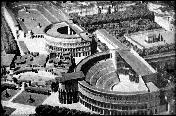 Later, in the first century BC, military leaders who celebrated victories held great games that often rivalled or surpassed those that were traditional. This lead to magistrates using games to gain public support and sway political opinions in their favour. With the end of the republic, the ludi became tools of control and power. Later, in the first century BC, military leaders who celebrated victories held great games that often rivalled or surpassed those that were traditional. This lead to magistrates using games to gain public support and sway political opinions in their favour. With the end of the republic, the ludi became tools of control and power.
Each emperor tried to surpass their predecessor with more spectacles to keep up public favour. By the end of the second century the number of ludi had reached one hundred thirty-five days per year. This continued to increase until the forth century with one hundred seventy-six days of games.
 The three main types of entertainment venues at the ludi were the circuses, the amphitheatres, and the theatre performances. All performances were completely spectacular for their time and would still be greatly impressive today. The Romans designed buildings dedicated to entertainment that could hold thousands of people. These buildings, athough in ruins today, still are spectacular monuments to the glory of Rome. The three main types of entertainment venues at the ludi were the circuses, the amphitheatres, and the theatre performances. All performances were completely spectacular for their time and would still be greatly impressive today. The Romans designed buildings dedicated to entertainment that could hold thousands of people. These buildings, athough in ruins today, still are spectacular monuments to the glory of Rome.
Circus
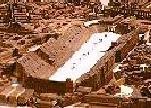 Chariot racing was the oldest entertainment in Rome. It was also the most popular venue by far. Chariot racing dated all the way back to the monarchy and founding of Rome. The Greeks also held chariot races and had a large influence on the Roman tradition. Chariot racing was not the only event held in the circuses. Wrestling and gladiator combats were also held in some cases, but chariot racing was the most common. The races were a very organised business that could lead to huge profits if successful. All competitors belonged to a faction. In late imperial times, there were four chariot factions, the Blues, the Whites, the Greens, and the Reds. The charioteers wore the colours of their faction when racing. The competition between these factions was fierce and often lead to violence. The factions most favoured by the public were the Greens and Blues. Chariot racing was a very dangerious occupation with most careers ending in death, although those who were successful became celebrities and heroes. Chariot racing was the oldest entertainment in Rome. It was also the most popular venue by far. Chariot racing dated all the way back to the monarchy and founding of Rome. The Greeks also held chariot races and had a large influence on the Roman tradition. Chariot racing was not the only event held in the circuses. Wrestling and gladiator combats were also held in some cases, but chariot racing was the most common. The races were a very organised business that could lead to huge profits if successful. All competitors belonged to a faction. In late imperial times, there were four chariot factions, the Blues, the Whites, the Greens, and the Reds. The charioteers wore the colours of their faction when racing. The competition between these factions was fierce and often lead to violence. The factions most favoured by the public were the Greens and Blues. Chariot racing was a very dangerious occupation with most careers ending in death, although those who were successful became celebrities and heroes.
 The circus building itself was based on the Greek hippodrome. The circus had seats for spectators around a "u" shaped arena. The racing took place in the arena around a barrier (spina) in the middle, with turning posts (metae) around each end. At one end of the arena were the starting gates. From these gates up to twelve, four horse chariots emerged. From here they proceeded right of the spina in a clockwise direction around the arena. At the end of one end of the spina were seven markers that indicated the lap. The race lasted for seven laps. Other races also took place, such as two horse chariots, horse races, and even foot races. The circus building itself was based on the Greek hippodrome. The circus had seats for spectators around a "u" shaped arena. The racing took place in the arena around a barrier (spina) in the middle, with turning posts (metae) around each end. At one end of the arena were the starting gates. From these gates up to twelve, four horse chariots emerged. From here they proceeded right of the spina in a clockwise direction around the arena. At the end of one end of the spina were seven markers that indicated the lap. The race lasted for seven laps. Other races also took place, such as two horse chariots, horse races, and even foot races.
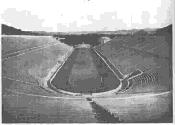 The first circus built in Rome was the Circus Maximus that was constructed during the monarchy. It was built completely from wood. Later it was rebuilt at various times. The final version could seat 250,000 people, it was build of stone and measured 400 m in length and 90 m in width. Various other stadia were built to hold races and were very popular. Stadia were similar to circuses, but had only one circular end and were half the size of the circus. They also had only two turning posts without the physical barrier. Circuses were mainly found in the west, and stadia in the east. The first circus built in Rome was the Circus Maximus that was constructed during the monarchy. It was built completely from wood. Later it was rebuilt at various times. The final version could seat 250,000 people, it was build of stone and measured 400 m in length and 90 m in width. Various other stadia were built to hold races and were very popular. Stadia were similar to circuses, but had only one circular end and were half the size of the circus. They also had only two turning posts without the physical barrier. Circuses were mainly found in the west, and stadia in the east.
Amphitheatre
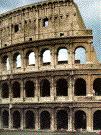 Amphitheatres were built to stage various types of violent entertainment. The arena in Latin was called the harena or arena, meaning sand. The arena was covered in sand to soak up the blood left over from the various spectacles. The most popular events to take place in the amphitheatres was gladiator combat. Gladiator combat evolved from Etruscan funeral games which in Roman times were called munera. The earliest known gladiator combat in Rome was in 264 BC. By the late first century, these fights had lost all religious importance. Gladiator training schools (schloae gladiatoriae), lead by a trainer (lanista) were developed to supply the increasing demand for gladiators. The men who usually became gladiators were convicted criminals, slaves, and prisoners of war. It is also known that people volunteered to become gladiators for a fee, even women were known to fight in gladiatorial combats. Amphitheatres were built to stage various types of violent entertainment. The arena in Latin was called the harena or arena, meaning sand. The arena was covered in sand to soak up the blood left over from the various spectacles. The most popular events to take place in the amphitheatres was gladiator combat. Gladiator combat evolved from Etruscan funeral games which in Roman times were called munera. The earliest known gladiator combat in Rome was in 264 BC. By the late first century, these fights had lost all religious importance. Gladiator training schools (schloae gladiatoriae), lead by a trainer (lanista) were developed to supply the increasing demand for gladiators. The men who usually became gladiators were convicted criminals, slaves, and prisoners of war. It is also known that people volunteered to become gladiators for a fee, even women were known to fight in gladiatorial combats.
There were four types of gladiators:
Myrmillo (= swordfish):
had a helmet with a fish crest, oblong shield and sword and usually fought a retiarius.
Retiarius (= fisher with a net):
was armed with a net and trident or dagger.
Samnis (= man from Samnium, Samnite):
had a short sword (gladius), visored helmet and oblong shield.
Thrax (= man from Thrakia, Thracian):
was armed with a curved dagger (scimitar) and round shield.
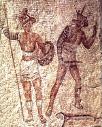 Performances with fights with wild animals were introduced in the early second century and instantly became very popular. These battles often involved combat between men and exotic animals, although, fights between animals were also common and took place on staged sets. The men who took part in these fights were called bestiarii and were convicted criminals, prisoners of war, or paid fighters. It was common for fights with animals to take place in the morning, and gladiator combats served as the grand finale in the evening. Performances with fights with wild animals were introduced in the early second century and instantly became very popular. These battles often involved combat between men and exotic animals, although, fights between animals were also common and took place on staged sets. The men who took part in these fights were called bestiarii and were convicted criminals, prisoners of war, or paid fighters. It was common for fights with animals to take place in the morning, and gladiator combats served as the grand finale in the evening.
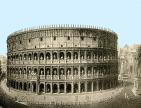 Unlike the other forms of entertainment, the ampitheater was completely original to Rome. Amphitheatres were mostly popular in the west, with few being found in the east except in areas of strong Greek influence. Originally circuses served as the venue to watch staged combat. It was not until 29BC when the first ampitheater was built that staged combat had its own venue. Amphitheatres were oval structures with sloping sides with seats for the spectators. In the middle of the building was the arena where the actual combat took place. Amphitheatre design was based on theatres, but soon developed into very complex engineered structures with various condors, staircases, trapdoors, and elevators. These all served the purpose to make the spectators more comfortable, and the events more spectacular. Because of the size of amphitheatres, they were often built on the fringes of towns. Military forts also usually had amphitheatres for training and performances of laudatios and awardings. Unlike the other forms of entertainment, the ampitheater was completely original to Rome. Amphitheatres were mostly popular in the west, with few being found in the east except in areas of strong Greek influence. Originally circuses served as the venue to watch staged combat. It was not until 29BC when the first ampitheater was built that staged combat had its own venue. Amphitheatres were oval structures with sloping sides with seats for the spectators. In the middle of the building was the arena where the actual combat took place. Amphitheatre design was based on theatres, but soon developed into very complex engineered structures with various condors, staircases, trapdoors, and elevators. These all served the purpose to make the spectators more comfortable, and the events more spectacular. Because of the size of amphitheatres, they were often built on the fringes of towns. Military forts also usually had amphitheatres for training and performances of laudatios and awardings.
Theatre
 Roman theatres were greatly influenced by Greek theatron. They became popular in Rome in the third century BC. During performances no women were allowed on stage, actors wore masks to distinguish between genders. The actors were often trained salves or freedmen, under the direction of a manager. From the first century BC, mimes became popular: actors mimed to music and elaborate effects, similar to a ballet. Unlike the earlier plays, tragedies and comedies, women were allowed to take part in mimes. Roman theatres were greatly influenced by Greek theatron. They became popular in Rome in the third century BC. During performances no women were allowed on stage, actors wore masks to distinguish between genders. The actors were often trained salves or freedmen, under the direction of a manager. From the first century BC, mimes became popular: actors mimed to music and elaborate effects, similar to a ballet. Unlike the earlier plays, tragedies and comedies, women were allowed to take part in mimes.
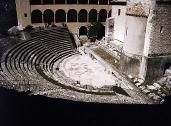 Originally in the third century BC, plays were performed in wooden buildings or at the circus. The first permanent theatre in Rome was built by Pompey in 55 BC. The design of Roman theatres was based on Greek design and were often built into a hillside with a circular orchestra and low stage opposite the auditorium. Most Roman theatres were free-standing structures, unlike Greek theatres. It was common to have a colonnade gallery in the top row of seats. There was also a masonry building behind their stage that was unique to the Romans. This room behind the stage often had many doorways for the actors to emerge and for the different effects to be performed. The back of the stage was also often highly decorated with columns and statues. In the front of the stage was a trench with a curtain to be raised and lowered at the start and the end of a performance. Smaller curtains were also on the stage itself, used to distinguish between scenes. The orchestra sat in a flat space between the stage and the auditorium. This space was also used as exclusive boxes for officials such as senators, magistrates, and priests. Above the stage was a wooden roof that served as as a sounding board. The audience was protected from the elements by an awning supported by ropes above the auditorium. Originally in the third century BC, plays were performed in wooden buildings or at the circus. The first permanent theatre in Rome was built by Pompey in 55 BC. The design of Roman theatres was based on Greek design and were often built into a hillside with a circular orchestra and low stage opposite the auditorium. Most Roman theatres were free-standing structures, unlike Greek theatres. It was common to have a colonnade gallery in the top row of seats. There was also a masonry building behind their stage that was unique to the Romans. This room behind the stage often had many doorways for the actors to emerge and for the different effects to be performed. The back of the stage was also often highly decorated with columns and statues. In the front of the stage was a trench with a curtain to be raised and lowered at the start and the end of a performance. Smaller curtains were also on the stage itself, used to distinguish between scenes. The orchestra sat in a flat space between the stage and the auditorium. This space was also used as exclusive boxes for officials such as senators, magistrates, and priests. Above the stage was a wooden roof that served as as a sounding board. The audience was protected from the elements by an awning supported by ropes above the auditorium.
Another type of theatre that was common was the odeum. The odeum was a specialised theatre for musical performances and recitations more refined than those shown in common theatres. Odeums were more common in the east than in the west and were of two types. The unroofed design was a smaller version of the common theatre. The roofed design was an enclosed square building with a roof. Any theatre with a roof was called odeum.
|
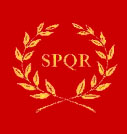

 Public entertainment was a very important aspect in Roman life, both in the city and provinces. Juvenal went as far to say that all the Roman public was interested in was panem et circenses (bread and circuses). Originally the ludi started as religious festivals, but over time the entertainment aspect grew to become more important than the religious observances.
Public entertainment was a very important aspect in Roman life, both in the city and provinces. Juvenal went as far to say that all the Roman public was interested in was panem et circenses (bread and circuses). Originally the ludi started as religious festivals, but over time the entertainment aspect grew to become more important than the religious observances. Over the years more ludi were added because of the great popularity with the Roman people. By 100 BC, six games had been held. In total this numbered about forty-nine days dedicated to games per year. Admission to the games was always free.
Over the years more ludi were added because of the great popularity with the Roman people. By 100 BC, six games had been held. In total this numbered about forty-nine days dedicated to games per year. Admission to the games was always free. Later, in the first century BC, military leaders who celebrated victories held great games that often rivalled or surpassed those that were traditional. This lead to magistrates using games to gain public support and sway political opinions in their favour. With the end of the republic, the ludi became tools of control and power.
Later, in the first century BC, military leaders who celebrated victories held great games that often rivalled or surpassed those that were traditional. This lead to magistrates using games to gain public support and sway political opinions in their favour. With the end of the republic, the ludi became tools of control and power. The three main types of entertainment venues at the ludi were the circuses, the amphitheatres, and the theatre performances. All performances were completely spectacular for their time and would still be greatly impressive today. The Romans designed buildings dedicated to entertainment that could hold thousands of people. These buildings, athough in ruins today, still are spectacular monuments to the glory of Rome.
The three main types of entertainment venues at the ludi were the circuses, the amphitheatres, and the theatre performances. All performances were completely spectacular for their time and would still be greatly impressive today. The Romans designed buildings dedicated to entertainment that could hold thousands of people. These buildings, athough in ruins today, still are spectacular monuments to the glory of Rome. Chariot racing was the oldest entertainment in Rome. It was also the most popular venue by far. Chariot racing dated all the way back to the monarchy and founding of Rome. The Greeks also held chariot races and had a large influence on the Roman tradition. Chariot racing was not the only event held in the circuses. Wrestling and gladiator combats were also held in some cases, but chariot racing was the most common. The races were a very organised business that could lead to huge profits if successful. All competitors belonged to a faction. In late imperial times, there were four chariot factions, the Blues, the Whites, the Greens, and the Reds. The charioteers wore the colours of their faction when racing. The competition between these factions was fierce and often lead to violence. The factions most favoured by the public were the Greens and Blues. Chariot racing was a very dangerious occupation with most careers ending in death, although those who were successful became celebrities and heroes.
Chariot racing was the oldest entertainment in Rome. It was also the most popular venue by far. Chariot racing dated all the way back to the monarchy and founding of Rome. The Greeks also held chariot races and had a large influence on the Roman tradition. Chariot racing was not the only event held in the circuses. Wrestling and gladiator combats were also held in some cases, but chariot racing was the most common. The races were a very organised business that could lead to huge profits if successful. All competitors belonged to a faction. In late imperial times, there were four chariot factions, the Blues, the Whites, the Greens, and the Reds. The charioteers wore the colours of their faction when racing. The competition between these factions was fierce and often lead to violence. The factions most favoured by the public were the Greens and Blues. Chariot racing was a very dangerious occupation with most careers ending in death, although those who were successful became celebrities and heroes. The circus building itself was based on the Greek hippodrome. The circus had seats for spectators around a "u" shaped arena. The racing took place in the arena around a barrier (spina) in the middle, with turning posts (metae) around each end. At one end of the arena were the starting gates. From these gates up to twelve, four horse chariots emerged. From here they proceeded right of the spina in a clockwise direction around the arena. At the end of one end of the spina were seven markers that indicated the lap. The race lasted for seven laps. Other races also took place, such as two horse chariots, horse races, and even foot races.
The circus building itself was based on the Greek hippodrome. The circus had seats for spectators around a "u" shaped arena. The racing took place in the arena around a barrier (spina) in the middle, with turning posts (metae) around each end. At one end of the arena were the starting gates. From these gates up to twelve, four horse chariots emerged. From here they proceeded right of the spina in a clockwise direction around the arena. At the end of one end of the spina were seven markers that indicated the lap. The race lasted for seven laps. Other races also took place, such as two horse chariots, horse races, and even foot races. The first circus built in Rome was the Circus Maximus that was constructed during the monarchy. It was built completely from wood. Later it was rebuilt at various times. The final version could seat 250,000 people, it was build of stone and measured 400 m in length and 90 m in width. Various other stadia were built to hold races and were very popular. Stadia were similar to circuses, but had only one circular end and were half the size of the circus. They also had only two turning posts without the physical barrier. Circuses were mainly found in the west, and stadia in the east.
The first circus built in Rome was the Circus Maximus that was constructed during the monarchy. It was built completely from wood. Later it was rebuilt at various times. The final version could seat 250,000 people, it was build of stone and measured 400 m in length and 90 m in width. Various other stadia were built to hold races and were very popular. Stadia were similar to circuses, but had only one circular end and were half the size of the circus. They also had only two turning posts without the physical barrier. Circuses were mainly found in the west, and stadia in the east. Amphitheatres were built to stage various types of violent entertainment. The arena in Latin was called the harena or arena, meaning sand. The arena was covered in sand to soak up the blood left over from the various spectacles. The most popular events to take place in the amphitheatres was gladiator combat. Gladiator combat evolved from Etruscan funeral games which in Roman times were called munera. The earliest known gladiator combat in Rome was in 264 BC. By the late first century, these fights had lost all religious importance. Gladiator training schools (schloae gladiatoriae), lead by a trainer (lanista) were developed to supply the increasing demand for gladiators. The men who usually became gladiators were convicted criminals, slaves, and prisoners of war. It is also known that people volunteered to become gladiators for a fee, even women were known to fight in gladiatorial combats.
Amphitheatres were built to stage various types of violent entertainment. The arena in Latin was called the harena or arena, meaning sand. The arena was covered in sand to soak up the blood left over from the various spectacles. The most popular events to take place in the amphitheatres was gladiator combat. Gladiator combat evolved from Etruscan funeral games which in Roman times were called munera. The earliest known gladiator combat in Rome was in 264 BC. By the late first century, these fights had lost all religious importance. Gladiator training schools (schloae gladiatoriae), lead by a trainer (lanista) were developed to supply the increasing demand for gladiators. The men who usually became gladiators were convicted criminals, slaves, and prisoners of war. It is also known that people volunteered to become gladiators for a fee, even women were known to fight in gladiatorial combats. Performances with fights with wild animals were introduced in the early second century and instantly became very popular. These battles often involved combat between men and exotic animals, although, fights between animals were also common and took place on staged sets. The men who took part in these fights were called bestiarii and were convicted criminals, prisoners of war, or paid fighters. It was common for fights with animals to take place in the morning, and gladiator combats served as the grand finale in the evening.
Performances with fights with wild animals were introduced in the early second century and instantly became very popular. These battles often involved combat between men and exotic animals, although, fights between animals were also common and took place on staged sets. The men who took part in these fights were called bestiarii and were convicted criminals, prisoners of war, or paid fighters. It was common for fights with animals to take place in the morning, and gladiator combats served as the grand finale in the evening. Unlike the other forms of entertainment, the ampitheater was completely original to Rome. Amphitheatres were mostly popular in the west, with few being found in the east except in areas of strong Greek influence. Originally circuses served as the venue to watch staged combat. It was not until 29BC when the first ampitheater was built that staged combat had its own venue. Amphitheatres were oval structures with sloping sides with seats for the spectators. In the middle of the building was the arena where the actual combat took place. Amphitheatre design was based on theatres, but soon developed into very complex engineered structures with various condors, staircases, trapdoors, and elevators. These all served the purpose to make the spectators more comfortable, and the events more spectacular. Because of the size of amphitheatres, they were often built on the fringes of towns. Military forts also usually had amphitheatres for training and performances of laudatios and awardings.
Unlike the other forms of entertainment, the ampitheater was completely original to Rome. Amphitheatres were mostly popular in the west, with few being found in the east except in areas of strong Greek influence. Originally circuses served as the venue to watch staged combat. It was not until 29BC when the first ampitheater was built that staged combat had its own venue. Amphitheatres were oval structures with sloping sides with seats for the spectators. In the middle of the building was the arena where the actual combat took place. Amphitheatre design was based on theatres, but soon developed into very complex engineered structures with various condors, staircases, trapdoors, and elevators. These all served the purpose to make the spectators more comfortable, and the events more spectacular. Because of the size of amphitheatres, they were often built on the fringes of towns. Military forts also usually had amphitheatres for training and performances of laudatios and awardings. Roman theatres were greatly influenced by Greek theatron. They became popular in Rome in the third century BC. During performances no women were allowed on stage, actors wore masks to distinguish between genders. The actors were often trained salves or freedmen, under the direction of a manager. From the first century BC, mimes became popular: actors mimed to music and elaborate effects, similar to a ballet. Unlike the earlier plays, tragedies and comedies, women were allowed to take part in mimes.
Roman theatres were greatly influenced by Greek theatron. They became popular in Rome in the third century BC. During performances no women were allowed on stage, actors wore masks to distinguish between genders. The actors were often trained salves or freedmen, under the direction of a manager. From the first century BC, mimes became popular: actors mimed to music and elaborate effects, similar to a ballet. Unlike the earlier plays, tragedies and comedies, women were allowed to take part in mimes. Originally in the third century BC, plays were performed in wooden buildings or at the circus. The first permanent theatre in Rome was built by Pompey in 55 BC. The design of Roman theatres was based on Greek design and were often built into a hillside with a circular orchestra and low stage opposite the auditorium. Most Roman theatres were free-standing structures, unlike Greek theatres. It was common to have a colonnade gallery in the top row of seats. There was also a masonry building behind their stage that was unique to the Romans. This room behind the stage often had many doorways for the actors to emerge and for the different effects to be performed. The back of the stage was also often highly decorated with columns and statues. In the front of the stage was a trench with a curtain to be raised and lowered at the start and the end of a performance. Smaller curtains were also on the stage itself, used to distinguish between scenes. The orchestra sat in a flat space between the stage and the auditorium. This space was also used as exclusive boxes for officials such as senators, magistrates, and priests. Above the stage was a wooden roof that served as as a sounding board. The audience was protected from the elements by an awning supported by ropes above the auditorium.
Originally in the third century BC, plays were performed in wooden buildings or at the circus. The first permanent theatre in Rome was built by Pompey in 55 BC. The design of Roman theatres was based on Greek design and were often built into a hillside with a circular orchestra and low stage opposite the auditorium. Most Roman theatres were free-standing structures, unlike Greek theatres. It was common to have a colonnade gallery in the top row of seats. There was also a masonry building behind their stage that was unique to the Romans. This room behind the stage often had many doorways for the actors to emerge and for the different effects to be performed. The back of the stage was also often highly decorated with columns and statues. In the front of the stage was a trench with a curtain to be raised and lowered at the start and the end of a performance. Smaller curtains were also on the stage itself, used to distinguish between scenes. The orchestra sat in a flat space between the stage and the auditorium. This space was also used as exclusive boxes for officials such as senators, magistrates, and priests. Above the stage was a wooden roof that served as as a sounding board. The audience was protected from the elements by an awning supported by ropes above the auditorium.